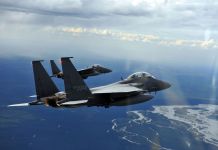Months after the French AMX-10RC light tanks were delivered to Ukraine and deployed in the ongoing counteroffensive, a Ukrainian commander called them unsuitable for combat operations against Russia.
Russian-Origin 4.5-Gen Air Superiority Fighter – Su-30SM2 – That Even The US Admires, Goes Down, One Pilot Dead
The open criticism from the Ukrainian commander coincides with a video showing a fully-loaded AMX-10RC light tank captured by the Russian forces.
The video, which some pro-Russian military bloggers posted, went viral on the internet, exposing the vulnerability of the French “light tank.” The vehicle, it has been alleged, was abandoned by the Ukrainians.
Against that backdrop, a Ukrainian military commander’s recent concerns become even more significant. The commander stated that the French-supplied light tanks were ineffective for frontline attacks due to their thin or light armor, as they were easily penetrated by artillery shells and other weapons fired by Russian troops.
The 37th Naval Infantry Brigade battalion commander, who goes by the pseudonym Major Spartanets, said, “Their thin armor is proving to be a major weakness in this high-intensity war marked by constant heavy artillery strikes.”
Spartanets further noted, “They are used for supporting fire because of their light armor. Their armament is good, and their observation instruments are very good. But unfortunately, it’s light armor, which makes them unsuitable.”
Russian troops captured a French wheeled tank AMX-10RC, abandoned by the Armed Forces of Ukraine in the Ugledar direction with full ammunition. pic.twitter.com/Oa68J8yRdo
— Milopotamus (@Xifidion) July 2, 2023
With an exhaustive list of reasons the Ukrainian Commander gave why the revered French light tanks are not living up to the hype with which they arrived in Ukraine in March this year, EurAsian Times decided to dive deep and analyze the claims.
French Light Tanks Not Efficient?
In January 2023, French President Emmanuel Macron confirmed plans to send an unspecified number of AMX-10 RC light tanks to the Ukrainian armed forces. “These are the first Western-made tanks that will be handed over to Ukraine,” said the French president.
Finally, in March, amid speculations that Ukraine was working on launching a massive counteroffensive against Russia, the French Armed Forces Minister Sebastien Lecornu confirmed the first AMX-10 RC armored vehicles delivered to Ukraine without specifying the number.
With Ukraine finally launching its much-anticipated counteroffensive against the Russians last month, the French AMX-10RC light tanks were also deployed for operations along with other Western equipment like the Leopard-2 Main Battle Tanks (MBTs) and the Bradley Infantry Fighting Vehicles (IFVs), which saw massive losses.
The officer told AFP that there had been instances where a 152mm Russian shell exploded nearby, and the shrapnel pierced the vehicle.
A shell exploded next to the lightly armored French light tank, the fragments pierced the armor, and the stock of ammunition (onboard) was detonated. “The crew of four, unfortunately, remained inside; they were killed in the armored vehicle.”
Early into the counteroffensive, the Ukrainian Navy’s 37th Marine Brigade attacked Russian positions in Velyka Novosilka in southern Donetsk Oblast. This is where the 37th Brigade deployed the AMX-10RC and suffered a lot of damage, despite faring well overall.

Ukrainian soldiers revealed that Russian artillery fragments easily penetrated the armor of these vehicles. Although not unexpected, this forced the Brigade to pull its 15-ton AMX-10RCs from the front of the assault force to the back.
While France has projected the AMX-10RC as a light tank, several experts have said it is merely an armored vehicle with better firepower.
Despite being resistant to small arms fire and shell fragments, the AMX-10 RC’s armor is not made to sustain direct impacts from larger weapons. Some projectile types, such as armor-piercing rounds, can also easily penetrate it.
Military experts believe the vehicle must be used with other armored vehicles and infantry assistance to reduce the risk of damage and losses. As per reports and different data sets available on the internet, it has an aluminum armor of 10 to 15mm thickness. This is why it qualifies as a lightly armored light tank.
The French have made no bone of that, asserting that it is thick enough to protect against shell splinters, machine gun bullets (most, if not all), and small cannon shells. However, it cannot withstand heavier attacks.
Assuming that it is indeed an armored vehicle, its armor is lighter than the American Bradley that the Ukrainian troops have extensively deployed. Besides Explosive Reactive Armor, the Bradley has a 14.5–30 mm thick all-around AP protection (depending on the variant).
Although there are fewer parallels between the Bradley and the AMX-10RC, both vehicles have been used by Ukraine to break through Russian defenses in its recent counteroffensive.
The Bradley is slightly heavier than the AMX-10RC and is used in conjunction with the MBTs. It is often known as the “buddy” to Abrams.
EurAsian Times reached out to a retired US Maj. Gen Patrick Donahoe, the former head of the US Army’s Maneuver Center of Excellence at Fort Benning, Georgia.
According to Donahoe, “Light tanks, armored cars, reconnaissance vehicles, infantry fighting vehicles, and main battle tanks all have a role on the battlefield. The 10RC was developed for French Cavalry (reconnaissance) units to provide additional direct-fire capability for the scouts as they made initial contact with the enemy.
At less than 20 tons, the RC was never intended to fulfill the role of the main battle tank, and it would be suicide to substitute the RC in that role.
It is not designed to destroy other armored vehicles in close combat. It is designed to allow reconnaissance elements freedom of maneuver versus enemy machine guns, pull boxes, and light armor. If the recon makes contact with complex obstacles and enemy armored formations, it’s time to bring up the heavy metal, and the cavalry moves to the flanks along with the RCs.”
When France first pledged the AMX-10C in January, military analysts warned that the vehicle should not be likened to the heavy MBTs that will be deployed in Ukraine and should be considered, deployed, and used as an armored vehicle and only for fire support.

AMX-10RC Has Its Advantages
The gun of the AMX-10RC is lethal enough to take down a tank at a close distance and would also be effective against troops and lighter armored vehicles. Its wheeled design allows it to maneuver quickly on roads and smooth terrain while requiring less upkeep than MBTs.
This could be one of the reasons why the Ukrainian forces might have deployed the vehicle at the front before it was jolted by Russian shells and had to push it back for fire support instead.
Unlike other armored vehicles that Ukraine has deployed, the AMX-10RC has armed with a 105mm cannon instead of the standard small cannon heavy machine gun.
After test-driving one of the vehicles in April, the Ukrainian defense minister Oleksii Reznikov said that the AMX-10RC, with its 105-millimeter main gun and day-night optics, is a “sniper rifle on fast wheels.”
In comparison, the M2 Bradley has a Boeing M242 Bushmaster 25mm chain gun coupled with a coaxial 7.62mm M240C machine gun.
The French military extensively used these war machines in its combat in Africa, where they proved reliable and reasonably mobile. However, they were reportedly too lightly armored to be considered for deployment in conventional battles involving tank-to-tank slug fights, anti-tank missiles, and intense artillery bombardment.
The French army primarily uses the AMX-10 as a reconnaissance vehicle, which will gradually be phased out in favor of the Jaguar. As per a Forbes report, Ukraine should ideally deploy the vehicles for the three functions primarily designed for scouting, reconnaissance, and exploitation.
In January, a French military expert, Michel Goya, observed that the exceptional mobility of these armored vehicles rendered them particularly effective “for use in ‘fire brigade’ units behind the front line” or for swiftly exploiting holes in the front line.
La voie de l'épée : AMX-Men
? https://t.co/aDvqpkaTmi pic.twitter.com/WAVQNByHT3— Michel Goya (@Michel_Goya) January 5, 2023
Despite this, he continued, the AMX-10 RC is not intended “for combat against battle tanks with heavier guns” and noted that its armor was unable to withstand “all the anti-tank weaponry of the modern battlefield.”
According to the Oryx website, at least three AMX-10 RCs have been “abandoned” after becoming unusable due to fighting at the front. This website tracks equipment losses on both sides using photographs that are freely available online.
Besides the literal vulnerability of its armor, Major Spartanets claimed that some AMX-10 RCs have also shown troubles with their gearboxes, which he thinks could be due to the dirt and mud on the roads they traverse. He said, “Sending these vehicles (to the attack) to be destroyed is (…) pointless because it is a risk mainly for the crew.”
Major Spartanets asserts that the American Oshkosh and British Husky light transport vehicles’ armor is more appropriate and efficient than that of the AMX-10 RC. Both are made to withstand ambushes and homemade explosive devices.
He displayed two Oshkosh used by his outfit to the AFP. One of them had some small pieces of shrapnel lodged in the bonnet. The vehicle is also quite cool, according to Spartanets, in terms of defense.
So while the French AMX-10RC is an excellent vehicle with great mobility and superior firepower, the verdict from Ukraine appears to be against deploying it as a main frontline vehicle and using it only with other tanks or armored vehicles as a fire support vehicle.
- Contact the author at sakshi.tiwari9555 (at) gmail.com
- Follow EurAsian Times on Google News




